Explore Scientific offers a variety of telescopes, eyepieces, and other accessories. Explore Scientific’s portfolio consists mainly of products made by Jinghua Optical Co., and as such, there is heavy overlap with Bresser products.
Explore Scientific’s eyepieces are unique in their lifetime transferable warranty (only for ES-branded items) and serial numbers. These are great to have and provide some assurance in case you have an accident and drop an eyepiece.
- Explore Scientific 100° & 120° Series Eyepieces
- Explore Scientific 92° Series Eyepieces
- Explore Scientific 82° Series Eyepieces
- Bresser 70° Series Eyepieces
- Explore Scientific 68° Series Eyepieces
- Explore Scientific 62° Series Eyepieces
- Explore Scientific 52° Series Eyepieces
- Explore Scientific Focal Extenders
- Explore Scientific Nebula Filters
Argon/Nitrogen Purging of Eyepieces
Another unique feature I noticed of Explore Scientific’s eyepieces is that all of their brand-name oculars are waterproofed with either nitrogen or argon. I’ve also seen considerable arguments as to whether the waterproofing of these eyepieces actually matters.
Older Explore Scientific eyepieces were nitrogen-purged. Nitrogen leaks more than argon, and as such, I only see the 20mm 100-degree offered by ES being sold with nitrogen purging, while everything else is now argon-purged.
The argon adds to the cost of these eyepieces, and while it does prevent internal fogging from humidity, you could just use dew heaters to avoid this problem happening with any eyepiece, and it won’t prevent the eye or field lens from fogging up on a damp night.
Likewise, the waterproofing and gas purging of the inside of these eyepieces prevent the growth of internal fungus, which can etch the coatings, but if you take care of your eyepieces at all by storing them with a desiccant pack in a case, this will not be a problem either.
Explore Scientific 100° & 120° Series Eyepieces
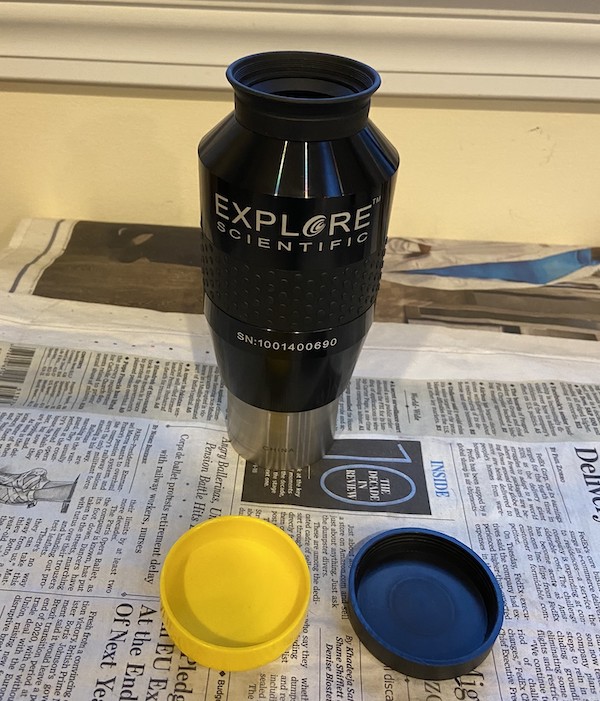
Pros:
- Huge 95/100/120-degree apparent field (depending on focal length)
- Some focal lengths sharp even in super-fast f/3 instruments
- Argon/nitrogen purging prevents fog or fungus
Cons:
- Heavy
- Most focal lengths not cost-effective compared to other options
- Glare and eye relief issues due to concave eye lens
ES100 is available in 30mm, 25mm, 20mm, 14mm, 9mm, and 5.5mm focal lengths.
With the exception of the 30mm 3” unit, the Explore Scientific 100-degree oculars are all 2”-only despite the fact that the 5.5mm, 9mm, and 14mm would actually work fine in a 1.25” barrel. You can use them with impunity in telescopes like a 6” SCT or a 5” Maksutov that will not actually illuminate a field stop wider than 1.25”, but attempting to adapt them to a Newtonian or refractor with a 1.25” focuser is probably a bad idea due to their weight and potential issues reaching focus.
ES120 is available in a single 9mm focal length. This eyepiece is over $1,000 USD new when not on sale, but I think it is well worth the price.
Explore Scientific’s 100-degree eyepieces are copies of the Tele-Vue Ethos design to some extent, and feature the same 100-degree apparent field of view – except for the 25mm, which has an apparent field of only 95 degrees due to limitations of the optical design.
The biggest difference in optical configuration between the ES100 and Ethos is the ES100s’ use of a concave eye lens. This means that they have shorter practical eye relief than technically specified, by around 4mm, and are thus not as comfortable for astronomy outreach purposes or eyeglasses wearers. Additionally, the concave eye lens is more prone to reflecting glare from light pollution, the Moon, and other sources back into your eye.
Prior to 2022, the ES100 line was considered a bargain alternative to the Tele-Vue Ethos line. These days, it is not universally the case. The 20mm ES100 is around the same price as the 21mm and 17mm Tele-Vue Ethos oculars, which are sharper and don’t feature the nuisance of concave eye lenses. The APM/Lunt/Astro-Tech XWA line is arguably equal to or superior to the ES100s and features 1.25” barrels for the shorter focal lengths, along with no concave eye lenses, lighter weight, and lower pricing.
The 30mm ES100 is a great eyepiece, but you might struggle to find a telescope that has a 3” focuser to accommodate it where such an eyepiece is worthwhile. However, in a long focal length Cassegrain, for instance, it is spectacular and sharp right out to the edges.
The 25mm ES100 has a wider field stop than any other eyepiece with a 90+ degree apparent field, and due to its pushing of the limits of optical design, it does have some edge-of-field astigmatism in fast f/ratio telescopes. However, it is still very comfortable to use and very sharp, while offering a capability no other 90-100 degree eyepiece line can attain.
The other ES100 eyepieces are decently well-corrected, but the 20mm and 14mm suffer from noticeable edge-of-field astigmatism in telescopes faster than f/3.5. The concavity of the eye lens is also, of course, somewhat annoying if you have any sources of glare/etc unless you put your face directly up against the eyeguard. However, they are still great eyepieces and work very well in almost any telescope.
In addition to the ES100 line, Explore Scientific sells a single 120-degree apparent field eyepiece in a 9mm focal length. Due to some interesting optical distortions with such a wide field of view, the field stop, or true field, is equivalent to that of a 140-degree apparent field eyepiece at this focal length (around 22mm), but the outer edges of the 9mm ES120’s field are “compressed” in such a way to deliver only a 120-degree apparent field. Eye relief is pretty short; the provided eyecup is often just a smidge too tall, while using the eyepiece with the eyecup rolled down gives the concave eye lens more opportunity to reflect sources of glare. Additionally, lateral chromatic aberration impacts planets and bright stars as they pass around the central 70-80 degrees of the field. However, for viewing the Moon and deep-sky objects – where the 120-degree apparent field is most useful anyways – this eyepiece is spectacular.
The ES100/120 eyepieces are heavy – the 5.5mm is the lightest at 21.6 oz/612 g, while the 25mm weighs 41.5 oz. The monster 30mm 3” weighs in at 83 oz. This can affect balance with telescopes that do not have adjustable or very large bearings of some sort.
Explore Scientific 92° Series Eyepieces
Pros:
- Huge 92-degree apparent field which is sharp at any focal ratio
- Plenty of eye relief, with large eye cups
- Argon purging prevents fog or fungus
Cons:
- Heavy
- Not as immersive as 100-degree apparent field
- Only two focal lengths available
Explore Scientific’s 92-degree eyepieces are optimized for long eye relief, and are available only in two focal lengths – 17mm and 12mm in 2” barrels. These eyepieces are similar to the ES100 optical design but trade some of the apparent field of view for greater eye relief, which makes for a much more comfortable viewing experience. The eye lenses are also enlarged. The ES92 eyepieces are a little sharper and provide better contrast than the ES100 eyepieces, though the former is partly due to the restricted apparent field of view, which of course shows fewer edge-of-field aberrations in fast f/ratio telescopes.
The ES92 eyepieces are both quite heavy, at 47 oz for the 17mm and 38.4 oz for the 12mm. This is, as with the ES100s, important to keep in mind if you plan on using them with smaller telescopes.
Explore Scientific 82° Series Eyepieces
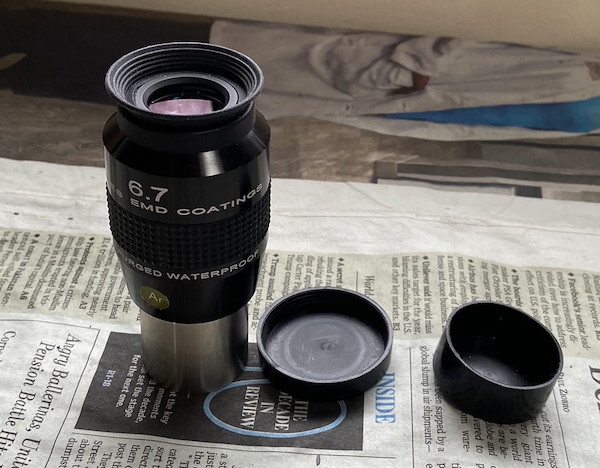
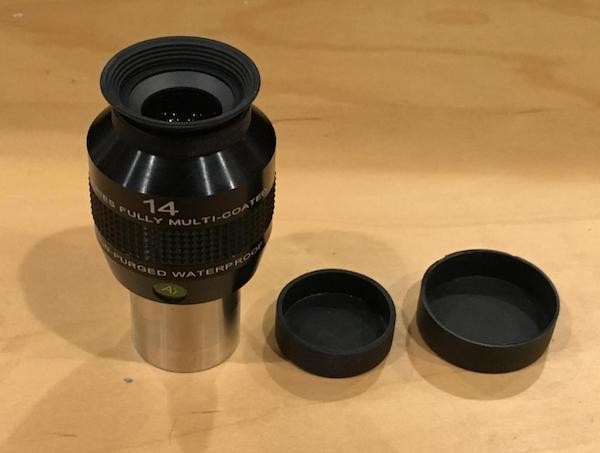
Pros:
- Wide 82-degree apparent field of view
- Cheaper than many other 82-degree eyepieces and sharper than bargain-basement models
- Argon purging prevents fog or fungus
Cons:
- Eye relief at some focal lengths is extremely short
- Some performance issues with certain focal lengths
Available Focal Lengths: ES82 eyepieces are available in 30mm, 24mm, 18m, 14mm, 11mm, 8.8mm, 8.5mm, 6.7mm, 6.5mm, 4.7mm, and 4.5mm focal lengths. The 30mm, 24mm, and 18mm ES82s are 2” while remaining focal lengths are 1.25”.
Recommended Focal Lengths: The 30mm, 24mm, and 18mm 2” ES82 eyepieces are all ideal low-power eyepieces for almost any telescope, and the 18mm is extremely lightweight at only 13.7oz, quite low for a 2” ocular, and ideal if you are concerned about the balance issues a heavier eyepiece might cause with your telescope. We don’t really recommend the 14mm and 1mm, or the older short focal length units of 8.8mm, 6.7mm and 4.7mm, but the new LER 8.5mm, 6.5mm, and 4.5mm ES82s are extremely comfortable and sharp with great performance in almost any telescope.
The Explore Scientific 82-degree series are essentially copies of the old Meade Series 5000 UWA eyepieces, which themselves are extremely good emulations of the Tele-Vue Nagler design.
The ES82 design is similar to the Type 4 and Type 5 Nagler eyepieces, and they perform very well even in fairly fast f/ratio telescopes. However, the 14mm unit is known to have some slight edge-of-field aberrations and field curvature, while the 11mm, 8.8mm, 6.7mm, and 4.7mm units are rather short on eye relief. To solve the latter issue, Explore Scientific has introduced longer eye relief 8.5mm, 6.5mm, and 4.5mm units to replace the aforementioned shorter focal length eyepieces, with improved performance while reducing glare and other aberrations. They are similar to the Type 6 Nagler design. The 11mm, however, is still short on eye relief, while the 14mm is still a little subpar.
Bresser 70° Series Eyepieces
Pros:
- Wide 70-degree apparent field of view
- Cheap
- Decent eye relief
Cons:
- Edge-of-field astigmatism and other aberrations in f/5.5 and faster telescopes
- Not waterproofed like other ES offerings
- Pretty much just a generic SWA/Erfle at a higher price tag
The Bresser 70-degree eyepieces sold by Explore Scientific are essentially Erfle-like “SWA” eyepieces. They are available in 2” 35mm, 30mm, and 25mm focal lengths, along with 1.25” 20mm, 15mm, and 10mm. These are just marked-up generic SWA eyepieces, which can be bought at lower or similar prices from other retailers. They have severe edge-of-field astigmatism in telescopes faster than f/5.5 or so, and the 1.25” versions are actually inferior to a typical “goldline” or “redline” eyepiece, which also usually boasts longer eye relief anyway. As such, while these eyepieces are acceptable, there is little point in buying them, especially when they also lack the waterproofing or warranty/serial number that Explore Scientific provides with their other brand-name eyepieces.
Explore Scientific 68° Series Eyepieces
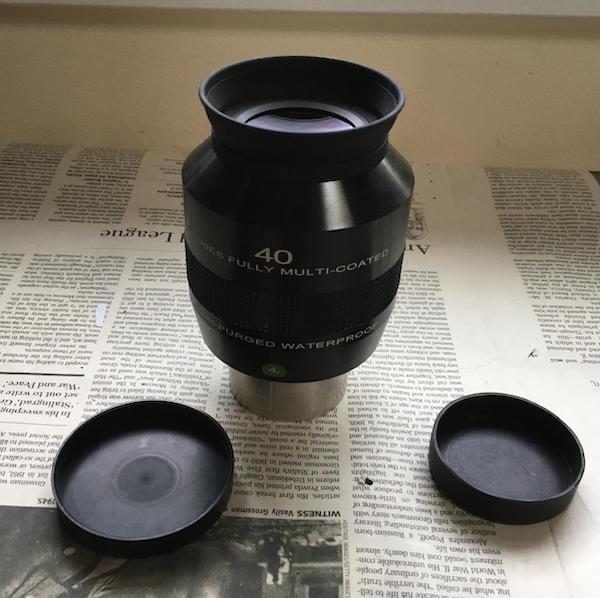
Pros:
- Wide 68-degree apparent field, remains fairly sharp in fast f/ratio telescopes
- Maximum true field achievable in respective formats with 40mm and 24mm focal lengths
- Argon purging prevents fog or fungus
Cons:
- Pincushion distortion/field curvature can be annoying
- Focal lengths too long for fast f/ratio telescopes
- Heavy
Copycats of the Tele-Vue Panoptic eyepieces, which themselves are essentially corrected Erfle/SWA designs, the Explore Scientific 68-degree series eyepieces are available in 2” 40mm, 34mm, and 28mm focal lengths, along with 1.25” 24mm and 16mm units. The performance is essentially the same as a Panoptic; field curvature is a nuisance in faster telescopes, but for slower instruments, these are ideal and cost-effective low-power eyepieces. For telescopes limited to a 1.25” focuser, the 24mm ES68 is one of the best low-power eyepieces there is to max out your true field of view.
Explore Scientific 62° Series Eyepieces
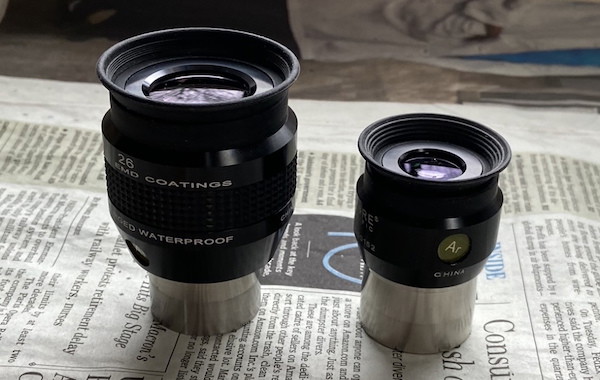
Pros:
- Wide 62-degree apparent field
- Long eye relief at all focal lengths
- Fairly lightweight/compact
- Argon purging prevents fog or fungus
Cons:
- Longer focal lengths not as immersive or sharp as ES68 equivalents
- Regular roll-up eyecups are not as ideal for this eyepiece design
- Some slight glare/scatter
Available Focal Lengths: The ES62 series offers 2” 40mm and 32mm units as well as 1.25” 26mm, 20mm, 14mm, 9mm, and 5.5mm focal lengths.
The Explore Scientific 62-degree series is an attempt to make an equivalent of the Tele-Vue Delite design, and features long eye relief as well as the same 62-degree apparent field of view. The 40mm and 32mm are nice for low power viewing and are tack-sharp, but you might be better served by something with a wider apparent field of view; the same goes for the 26mm, which largely duplicates the 24mm ES68 in form and function.
The shorter focal length ES62 oculars are great for binoviewers, planetary viewing, or if storage space is a concern, but they aren’t anything magical, and for the price, you could get something with a larger field of view if you care. However, the performance of these eyepieces is excellent, and they are certainly some of the better sub-$150 eyepieces out there.
Eye relief is consistently over 10mm; the 32mm and 40mm offer 22mm and 28mm of eye relief, respectively, which is in line with typical 2” wide-angle oculars, while the 14mm is oddly short in eye relief at only 10.5mm, probably because the shorter focal length ES62s use an internal Smyth lens to increase eye relief by acting as essentially an internal Barlow for an otherwise longer focal length design.
Explore Scientific 52° Series Eyepieces
Pros:
- Sharp 52-degree apparent field
- Long eye relief at all focal lengths, unlike a regular Plossl
- Fairly lightweight/compact
- Argon purging prevents fog or fungus
Cons:
- 52-degree apparent field is kind of narrow
- Cheaper equivalents available, or you could get a wide-angle eyepiece for the same price
- Slight chromatic aberration
Available Focal Lengths: The 40mm is a 2”, while the 30mm, 25mm, 20mm, 15mm, 10mm, 6.5mm, 4.5mm, and 3mm units are all 1.25”.
Essentially Plossls, the Explore Scientific 52-degree series eyepieces use an internal Smyth/Barlow lens in the shorter focal length oculars to maintain eye relief of 15mm or greater as with many other “planetary” eyepieces which are all just Barlowed Plossl or Erfle designs, including the “goldline” and “redline” oculars.
While there is a bit of an increase in sharpness over cheaper “planetary” eyepieces, at the end of the day, the ES52 series are simply above-average Plossl-like eyepieces, and the 52-degree apparent field is often unappealing to observers; the narrow field lacks immersion for low-power deep-sky viewing while objects will drift out of the field faster with a manual scope compared to a wide-angle eyepiece at high power. These are certainly good eyepieces, but a 60-degree or wider apparent field of view is a lot more comfortable for most observers to use.
Explore Scientific Focal Extenders
Explore Scientific’s Focal Extenders are similar to the Tele-Vue Powermate design, with focal length amplification that does not vary based on eyepiece design or spacing. The 2” units are available for 23 and 3x, while 1.25” 2x, 3x, and 5x focal extenders are also offered. The 2” focal extenders are far too heavy to be of much practical value, but the 1.25” 2x is ideal for visual use with many eyepieces, while the 3x and 5x are perfect for planetary imaging with a suitable telescope and camera in order to achieve the right image scale.
Explore Scientific Nebula Filters
Explore Scientific offers 1.25” and 2” screw-on nebula filters for visual and imaging use. The CLS filter works as a broadband imaging filter, but is of little use for visual observation due to its extremely wide band pass of 100 nanometers, which won’t filter out sky glow’s effects on nebulae to any particular degree at the eyepiece and will simply dim your view of star clusters and galaxies. The Explore Scientific “Oxygen-III” and “H-Beta” filters both have a rather wide bandpass – the OIII’s is 28nm while the H-Beta is 18nm, which makes them too wide to be of much use; an emission line filter for either is usually a 10-15nm band pass. The OIII filter’s 483-511 nanometer band pass is actually similar to that of a typical UHC filter, and overlaps with the H-Beta filter almost entirely (it allows in 478-496nm) but it is rather wide in band pass even for that and won’t enhance contrast as well as a good UHC filter that performs as advertised.
Similarly, the UHC filter offered by Explore Scientific has a band pass of a whopping 50 nanometers! This is more than twice the typically accepted amount for a UHC filter, and it will let in far too much background sky glow to do much for improving your views. As such, Explore Scientific’s nebula filters are pretty much a waste of time and your money, and we recommend steering clear and choosing from a more reputable manufacturer of filters. Their expertise in eyepiece design simply does not transfer to the filter department at all.

Does Explore Scientific 14mm 62° with 1.7x APO barlow might produce better sharpness and contrast than 9mm Svbony Redline 70 deg?
https://www.astroshop.eu/eyepieces/explore-scientific-ler-ar-1-25-14mm-62d-eyepiece/p,53323
Not really, the redline is pretty darned good.